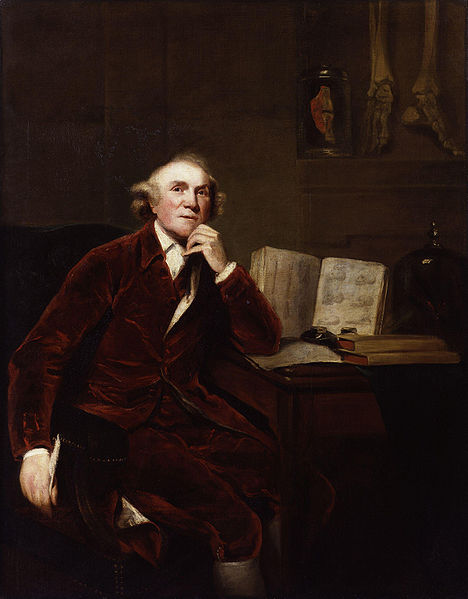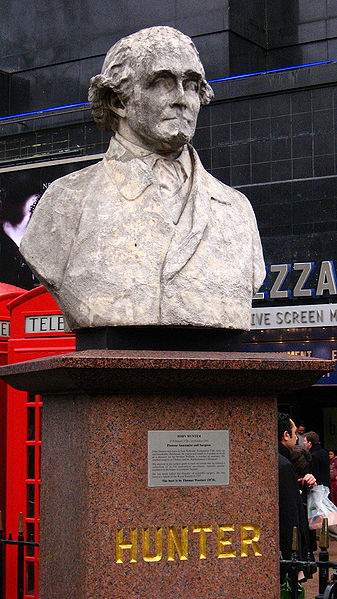<Back to Index>
- Surgeon John Hunter, 1728
- Painter Giovanni Battista Piazzetta, 1682
- Prime Minister of Greece George Papandreou, 1888
PAGE SPONSOR


John Hunter FRS (13 February 1728 – 16 October 1793) was a Scottish surgeon regarded as one of the most distinguished scientists and surgeons of his day. He was an early advocate of careful observation and scientific method in medicine. The Hunterian Society of London was named in his honour.
Hunter was born at Long Calderwood, then near East Kilbride, Lanarkshire, Scotland, the youngest of ten children. Three of these children had died of illness before John Hunter was born. One of these three had been named John Hunter also. An elder brother was William Hunter, the anatomist. As a youth, John showed little talent, and helped his brother-in-law as a cabinet maker.
In 1771 he married Anne Home, daughter of Robert Boyne Home and sister of Sir Everard Home. They had four children, two of whom died before the age of 5 and one of whom, Agnes (their fourth child), married General Sir James Campbell.
His death in 1793 followed a heart attack during an argument at St George's Hospital over the admission of students.
When nearly 21 he visited William in London, where his brother had become an admired teacher of anatomy. John started as his assistant in dissections (1748), and was soon running the practical classes on his own.
Hunter studied under William Cheselden at Chelsea Hospital and Percival Pott at St. Bartholomew's Hospital. After qualifying he became Assistant Surgeon (house surgeon) at St George's Hospital (1756) and Surgeon (1768). He was commissioned as an Army surgeon in 1760 and was staff surgeon on expedition to Belle Île in 1761, and served in 1762 with the British Army in the expedition to Portugal.
Hunter was an excellent anatomist; his knowledge and skill as a surgeon was based on sound anatomical background. Among his numerous contributions to medical science are: study of human teeth; extensive study of inflammation; fine work on gun-shot wounds; some work on venereal diseases, including possibly inoculating himself with venereal disease in 1767 to carry out further study; an understanding of the nature of digestion, and verifying that fats are absorbed into the lacteals, a type of small intestine lymphatic capillary, and not into the intestinal blood capillaries as was generally accepted; the first complete study of the development of a child; proof that the maternal and foetal blood supplies are separate; unravelling of one of the major anatomical mysteries of the time – the role of the lymphatic system
After years of hard work he set up his own anatomy school in London in 1764 and started in private surgical practice. His recognition rose in 1767 when he was elected as Fellow of the Royal Society and in 1768 he was appointed as surgeon to St. George's Hospital. Later he became a member of the Company of Surgeons. In 1776 he was appointed surgeon to King George III; in 1786 he was appointed deputy surgeon to the British Army and in 1789 he was made Surgeon General.
In 1783 Hunter moved to a large house in Leicester Square, where today there stands a statue to him. The space allowed him to arrange his collection of nearly 14,000 preparations of over 500 species of plants and animals into a teaching museum.
Also in 1783 he acquired the skeleton of the 7' 7" Irish giant Charles Byrne against Byrne's clear deathbed wishes – he asked to be buried at sea. Hunter bribed a member of the funeral party (possibly for £500) and filled the coffin with rocks at an overnight stop, then subsequently published a scientific description of the anatomy and skeleton. The skeleton today is in the Hunterian Museum at the Royal College of Surgeons in London.
In 1799 the government purchased Hunter's collection of papers and specimens, which it presented to the Company of Surgeons.
It has
recently been alleged that Hunter's brother William,
and his brother's former tutor William
Smellie, were responsible for the deaths of many women whose
corpses were used for their studies on pregnancy. John is alleged to have
been connected in some way to these murders. Hunter's
character has been discussed by biographers: In
general, he had a reputation as a blunt speaker with an argumentative
nature. Hunter
was the basis for the character "Jack Tearguts" in William
Blake's unfinished satirical novel, An
Island in the Moon. He is a principal character in Hilary
Mantel's 1998 novel, The
Giant, O'Brien. A bust of
John Hunter stands on a pedestal outside the main entrance to St
George's Hospital in Tooting,
South London, along with a lion and unicorn taken from the original
Hyde Park Corner building. There is also a bust of him in Leicester
Square in London's
West End and in the South West corner of Lincoln's
Inn Fields. The John
Hunter Hospital, the largest hospital in Newcastle,
New South Wales, Australia, and principal teaching hospital of the University of Newcastle, is named after Hunter (as well as two other
historically significant John Hunters).